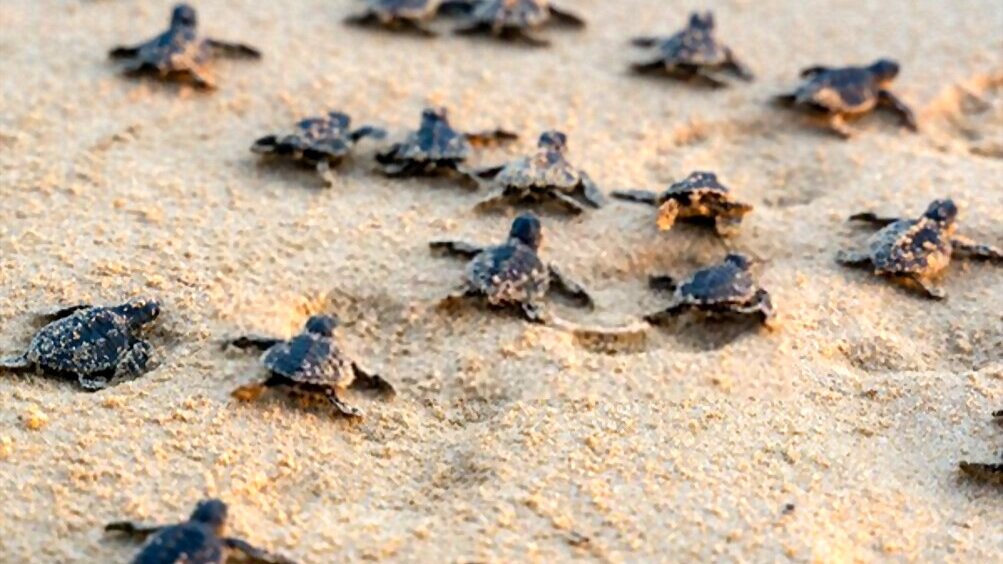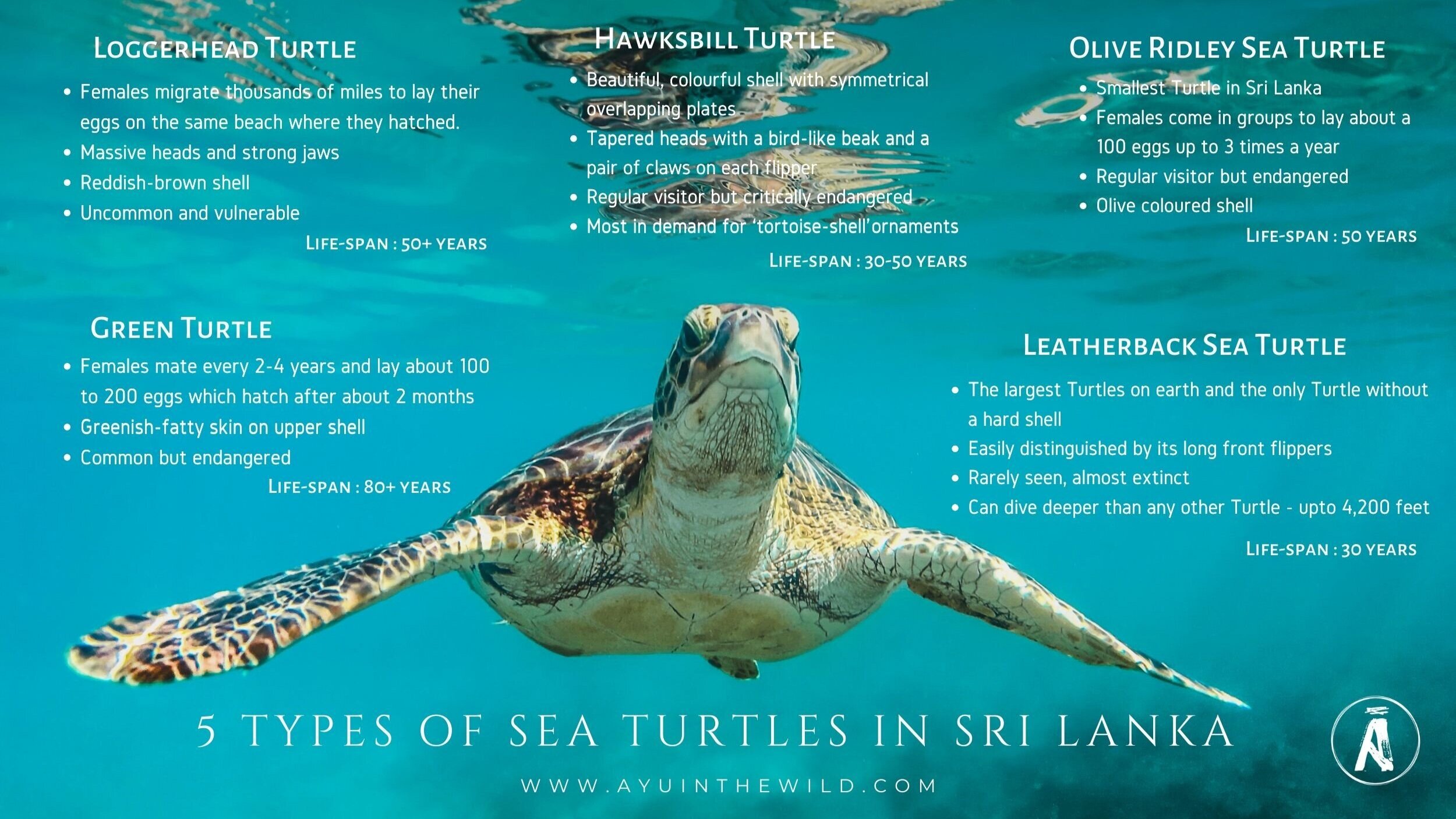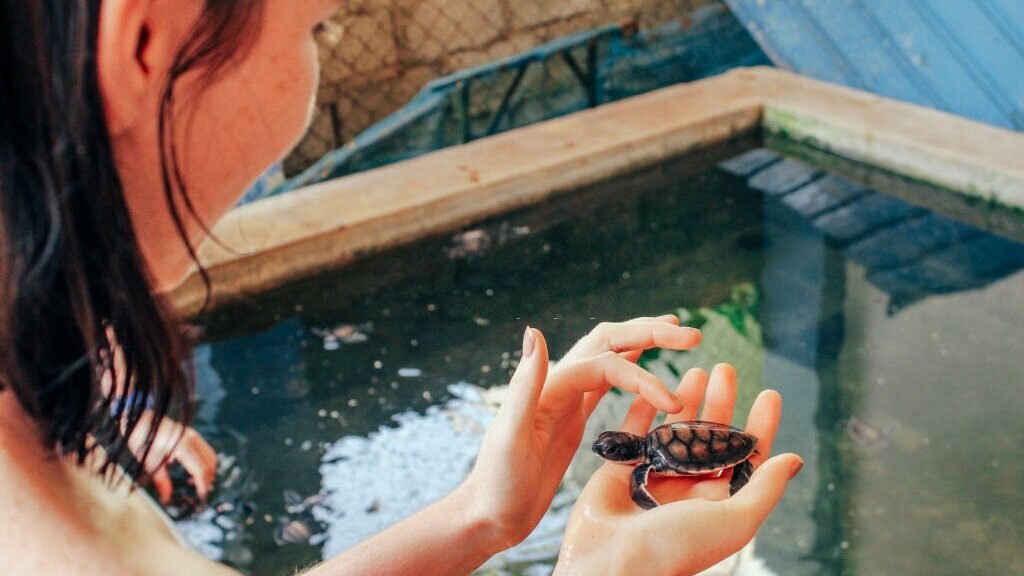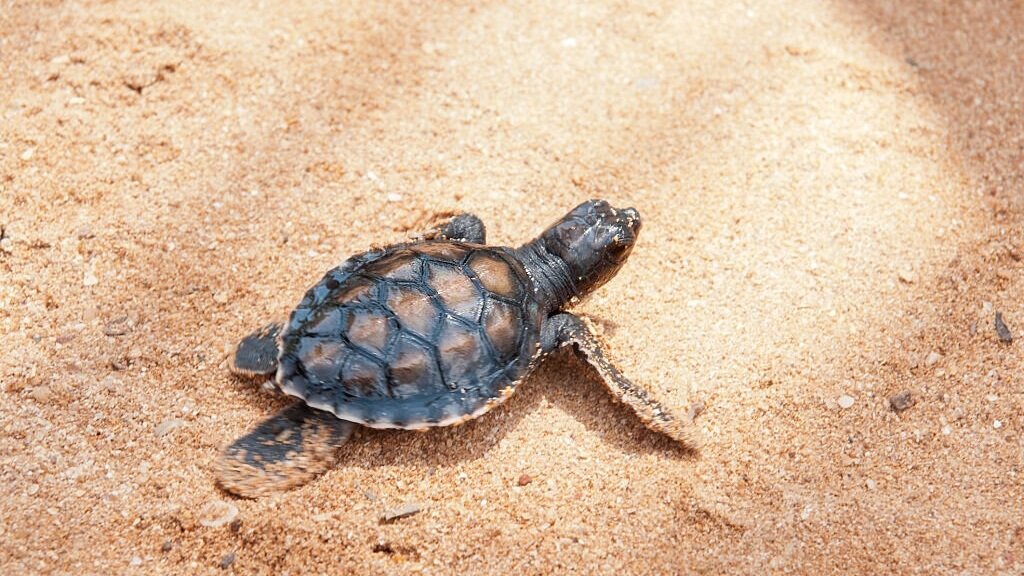NO Turtle Hatcheries on Our Sri Lanka Wildlife Holidays
Should you visit a Turtle Hatchery in Sri Lanka?
At Ayu in the Wild, we would say ‘no, not before you ask them the right questions.’
Here’s why the answers may alarm you, and why we feel there needs to be greater regulation.
Turtles in Sri Lanka
Five beautiful sea turtle species call Sri Lanka’s warm Indian ocean waters, their home. Returning decades after they were born, to the beautiful beaches of Sri Lanka to give birth to their own young. We long for the day when regulated tourism can spur Turtle Hatcheries to become benchmark conservation projects to protect these gentle creatures.
Poaching and Manhandling of Turtle Eggs and Hatchlings for Tourism
These wonderful gentle creatures, who can live beyond 80 years depending on their species, are protected under the Fauna and Flora Ordinance in Sri Lanka and Turtle Conservation projects and hatcheries should play a vital role to ensure a thriving population of wild turtles. Without conservation efforts, the consumption of turtle eggs will continue unabated resulting in dwindling the population of these beautiful oceanic wildlife in Sri Lanka.
Yet, are they really protected in the Turtle Hatcheries that use tanks?
The reason why we do not promote a visit to a Turtle Hatchery as one of our top things to do on a holiday to Sri Lanka is not because we are against the conservation efforts of any project along the beautiful but populated tourist hotspots of Hikkaduwa, Galle, Kosgoda, Mirissa, Weligama, Habaraduwa, Hambantota, Rekawa, Tangalle etc., but because we are yet to come across the right answers to our questions posed about the process of handling turtle eggs, and releasing hatchlings in the name of ‘conservation’.
Ask If Your Tourist Dollars are Fueling Irresponsible Wildlife Tourism
Female Turtles are some of the greatest navigators in the seas, often undertaking migrations from their feeding sites that are hundreds, sometimes thousands of miles away to nesting grounds used by their mothers! Females can lay a large clutch of eggs that can include a mix of males and females - sometimes in their hundreds, after digging a pit in the sand with their flippers. Eggs take about two months to hatch. The temperature inside the nest determines the sex of the hatchlings with higher temperatures producing more females.
Locals living along the southern coast of Sri Lanka depend on tourism to earn a living but exploitation of baby turtles and turtle eggs by poaching them is fueled by the high demand from unscrupulous Turtle Hatcheries that keep them in (sometimes unhygienic) tanks merely to earn from tourism. Turtle eggs are a delicacy and regulated conservation efforts are needed to ensure these eggs are allowed to hatch in safe, hygienic environments. Yet, are the Turtle Hatcheries regulated sufficiently?
Ayu in the Wild posed some questions to a random selection of 8 Turtle Hatcheries along the southern coast that are popularly visited on holidays to Sri Lanka. If you are planning your tour to Sri Lanka we would always advice that you avoid visiting turtle hatcheries that keep turtles in tanks or at least ask some questions prior to the visit, to ascertain if the Turtle Hatchery adopts responsible practices aimed at conserving turtles.
Some Turtle Hatcheries refused to answer our questions while the answers given by others were quite alarming. They indicated that they purchase turtle eggs from residents in the area - the higher bidders securing more eggs than others; no gloves are used when reburying the eggs or handling the hatchlings, making them highly vulnerable to infections and later deformities; only 70%-80% of the hatched baby turtles are released while others are kept back for tourism. One even admitted they try to increase the temperature of the nest to obtain more female Turtles (the temperature affects the sex of the embryos).
Why It’s Important to Decide If A Turtle Hatchery is ‘Responsible’
Q : Are turtle eggs removed from the nest on the beach and placed in a tank just to show tourists, or due to a natural threat to the eggs?
In many countries across the world where sea turtles thrive, wildlife conservation efforts are not profit led. Experienced and educated wildlife officers patrol beaches frequented by nesting turtles to remove natural nests only if they are faced with threatened conditions; like being too close to the high tide, erosion, predatory animals, visitors in public beaches inadvertently stepping on them etc. The nests are safely relocated on the same beach or nearby, cordoned off and monitored. The role of a Turtle Hatchery should be to patrol the beaches to prevent poaching. Instead, when eggs are stolen from the nests simply because Hatcheries are purchasing them - sometime outbidding each other, it encourages poachers to steal as many eggs as possible - even if the nests are not threatened.
Q: Are the eggs re-homed in artificial nests which can lead to infections or reburied in protected parts of the beach?
Turtle Eggs and hatchlings are highly vulnerable to infections – both bacterial and fungal. Disease spreads easily if re-homed without due care. Even if reburied in protected parts of the beach the sand must be maintained at the correct conditions - if too dry, the eggs will dehydrate and curtail development of the embryos; if too wet, the embryos will lack sufficient oxygen for growth. Eggs must also be re-homed quickly, possibly within a couple of hours of being laid to increase chances of survival in re-homed nests. Most hatcheries re-home the eggs in plastic buckets or tiny containers which themselves may not be hygienic. The tanks that keep the hatchlings allows the risk of disease transmission among the hatchlings, who when released into the ocean, may pass on diseases to wild turtles.
Q: Are eggs and hatchlings handled without gloves, making them highly vulnerable to infections and later deformities?
Please do not touch turtle eggs and hatchlings. Eggs and hatchlings should not be handled unless absolutely threatened and needs to be re-homed for their protection or needs to be released without delay, in which case the use of latex gloves is essential. All Turtle Hatcheries we contacted said they do not use gloves to handle and many reported a high rate of deformities among the hatchlings.
Q: Is the temperature of the nest controlled as the temperature affects the sex of the embryos?
Some Hatcheries we spoke with were aware of the effect of controlled temperature on the sex ratios but did not manipulate it while others increased the temperature to get more female hatchlings. Many embryos die if the temperatures are too high or too low.
Q: Are artificial nests dug in a different location each year to prevent the spread of disease or at the very least is the sand “treated” before being used again?
When baby turtles hatch the fluid that leaks from their egg becomes home to bacteria and can spread disease if used again within two years without a sand treatment process. The best option would be to leave the eggs where the female laid them in situ cordoned off, or if threatened then to dig an artificial nest in a different location nearby; or treat the sand well and allow it to dry.
Q: Are hatchlings released on the same day as any delay will interfere with the "imprinting" process?
Females migrate thousands of miles to return decades after they were born to the same beach that their mothers nested. This ability to ‘imprint’ (or memorize) their place of birth is part of the intriguing life cycle of sea turtles. However, many Turtle Hatcheries that are touted as responsible conservation projects appear to keep hatchlings for days on end in tanks in the guise of conservation. TripAdvisor reviews of many visitors to these hatcheries reveal how they observed, and handled baby turtles in tanks that were days, weeks and months old.
The secret of survival for the little hatchlings is to use their limited energy to swim into the deep seas, away from predators, soon. If the eggs hatch during the day, the hatchlings need to be kept in damp sand in darkness and released that night from the same location. A confinement in a tank of water for a few days not only interferes with their ‘imprinting’ process where they are able to imprint in their memory a magnetic location that will allow females to return as adults to the same beach to lay her eggs; but also makes them expend too much energy swimming around in the tank and limits their ability to swim the distance into the deeper seas.
Q: If volunteers are accepted, are there qualified experts in turtle conservation to train the volunteers?
Many Turtle Hatcheries are run by locals who have lived in these nesting areas all their lives. Some are keenly aware of nesting behaviour and patterns and can share their wonderful local knowledge, but many may not be aware of the actual conservation methods that should be followed. A review of the Turtle Hatcheries on Tripadvisor reveals volunteers handling eggs and hatchlings without gloves, visitors have commented how they have observed turtles from several days old to several months old that have been kept in tanks – when in fact, they should have been released immediately. Irresponsible interference in the nesting process is one of the biggest threats to sea turtles and can affect nesting habits for decades to come.
If in doubt, about the availability of expertise and trained staff, do not volunteer. Or visit.
Q: Are the numbers of tourists or volunteers kept to a minimum to avoid causing distress to Turtles?
A female turtle that is distressed by large crowds, and beams of white torch light may even avoid releasing her clutch of eggs in the sand, instead returning to sea and releasing them in the water where they will not survive.
C for Conservation. D for Discussion.
A wonderful alternative to visiting a turtle hatchery on your holiday to Sri Lanka, is to stay in the many beach hotels where you could keep your distance and quietly observe turtles in their natural habitat, swimming in the ocean or coming ashore. Avoid disturbing the nesting females if you observe them close to your hotel at night or dawn, do not get close to them and do not shine a bright light while they release their clutch of eggs.
Turtle hatcheries, if regulated, would be such a wonderful conservation effort! If left unregulated, then we would need be completely sure that the owners are willing to discuss the bona fides of their conservation efforts. Are they really about the well-being of the beautiful wildlife of Sri Lanka, or is it about Turtle-tourism dollars?
When we do come across a wonderful Turtle Conservation effort, we will stand corrected and will endorse their efforts wholeheartedly; but, until we find the right answers, Turtle Hatcheries will not be a part of Ayu in the Wild’s Sri Lanka wildlife holidays or any bespoke tours to Sri Lanka.
We believe the future of tourism in Sri Lanka rests, not in higher visitor arrivals, but in aggressively pursuing that difficult balance between conserving biodiversity, respecting animals and engaging with people.
For the most responsible tailor-made holidays to Sri Lanka - Email: info@ayuinthewild.com
or
Whatsapp us on +94 77 248 1100









